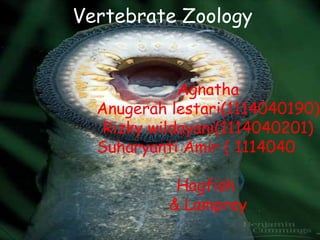
Agnathans 2
- 1. Vertebrate Zoology Agnatha Anugerah lestari(1114040190) Rizky wildayani(1114040201) Suharyanti Amir ( 1114040 Hagfish & Lamprey
- 2. Key Features o Jaws are absent. o Paired fins are generally absent. o Early species had heavy bony scales and plates in their skin
- 3. Key features con’t In most cases the skeleton is cartilaginous. The embryonic notochord persists in the adult. Seven or more paired gill pouches are present. Hagfish sheds slime layer The mouth is in ventro-anterior and plays role as a sucker
- 4. Key features con’t A light-sensitive pineal eye is present. The digestive system lacks a stomach. External fertilization; both ovaries and testes present in individual but gonads of only one sex functional in hagfishes, no larval stage; separate sexes and a long larval stage in lampreys.
- 5. Systema Digestoria Consist of ventral mouth contained within buccalis closed or open channel by moving the shape of “platuk “tongue.
- 6. Skeleton system Notochord are partial body axis, in the form of cylindrical rods of gelatin material encased by connective tissue. Part skeleton other form cartilage.
- 7. Excretory system Two kidney (mesonephros) located next to the dorsal body cavity: an elongated ureter vessels of each mesonephros until urogentalis , which then emptied its contents through urogenital papilae.
- 8. Respiration system Among the respiratory tract and the body wall are 7 pairs of gills in kentung gill-sac which is located next to the contiguous. Each sheet contains gill capillaries
- 9. Circulation system The shaped is like trophies at the end of the posterior pocket located inside the cavity related pericardial cavity coelom.
- 10. Digestoria system Consist of ventral mouth contained within buccalis closed or open channel by moving the shape platuk tongue.
- 11. Sensoris Nasal cavity open toward the saccus olfactorious gets olfactorious nerves from both lobes of the brain. There pinealis the lensed eyes bright and pigmented retine. Necrotic foci in the pharynx and flavorings are contained in the next line laterals contiguous body contains the sense of touch.
- 12. Reproduction system Phase starters could not distinguish between males and females, the next phase will grow into males and females.
- 16. Hagfish Classification • Kingdom Animalia • Phylum Chordata • Class Pteraspidomorphi • Order Myxiniformes • Family Myxinidae • Genus Myxine • Species Myxine glutinosa
- 18. Slime Glands
- 21. Hagfish Hagfish can be found in chilly waters They tend to live on and in muddy sea floors in very dense groups (up to 15,000 in an area). Because females tend to produce large eggs in small numbers, their population sizes suggest a low death rate.
- 22. Hagfish • Diet is made up of marine worms and other invertebrates • They have a ring of short sensitive tentacles around their mouths. • Large slime glands line their sides along the length of their bodies. • Can sneeze to clear slime from nostrils
- 23. No jaws. Instead they have two pairs of rasps on top of a tongue. They pull meat into their mouths with the tongue, then tear it off the prey with the rasps.
- 25. Hagfish Anatomy
- 26. Hagfish have a very low metabolism. Once they eat, they may not have to again for up to seven months. Although hagfish have a partial skull, they have no back bone, so are not true vertebrates. What skeleton they do have is made of cartilage.
- 28. Lamprey Classification Kingdom Animalia Phylum Chordata Subphylum Vertebrata Class Cephalaspidomorphi Order Petromyzontiformes Family Petromyzontidae Genus Petromyzon Species Petromyzon marinus
- 30. Lamprey Dissection External Mouth Head & Pharynx Heart Gonads
- 31. IC RI ST AC TE AR CH The body shape is round-long shape or cylinder, the tail is flat The mouth is in ventro-anterior and plays role as a sucker Bones of head and archus viceralis are made by hondrocyte bone The blood contains round leucocyte and erythrocyt which have nucleus In the right and left area of pharynx, there are 6-14 pairs of gill which put in a sack The brain has growth well with 8-10 pairs of cranialis nervous Term of body depens on environment ( poikilothermis) The fertilization happens outside, egg will attaches to be larva ( Pe tro m y z o n m a rinus ), or egg will grow to be
